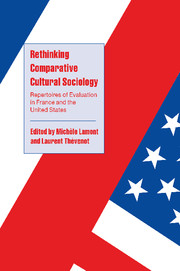Book contents
- Frontmatter
- Contents
- Notes on contributors
- Acknowledgements
- 1 Introduction: toward a renewed comparative cultural sociology
- Part I Race, gender, and multiculturalism
- Part II The cultural sphere: publishing, journalism, and the arts
- 5 Culture or commerce? Symbolic boundaries in French and American book publishing
- 6 Involvement and detachment among French and American journalists: to be or not to be a “real” professional
- 7 From rejection of contemporary art to culture war
- Part III Political cultures and practices
- Conclusion: Exploring the French and the American polity
- References
- Index
7 - From rejection of contemporary art to culture war
Published online by Cambridge University Press: 26 March 2010
- Frontmatter
- Contents
- Notes on contributors
- Acknowledgements
- 1 Introduction: toward a renewed comparative cultural sociology
- Part I Race, gender, and multiculturalism
- Part II The cultural sphere: publishing, journalism, and the arts
- 5 Culture or commerce? Symbolic boundaries in French and American book publishing
- 6 Involvement and detachment among French and American journalists: to be or not to be a “real” professional
- 7 From rejection of contemporary art to culture war
- Part III Political cultures and practices
- Conclusion: Exploring the French and the American polity
- References
- Index
Summary
Contemporary art shifts the boundaries that define what constitutes a work of art: mental or cognitive boundaries that mark the distinction between art and non-art; material boundaries such as the walls of museums, galleries, and auction houses or such as the pages of specialized reviews, catalogues, and art books (Heinich 1986, 1997a). There is no better way to study these shifts than via the negative reactions to works of art or proposals that breach the boundaries of common sense, shared references, and generally accepted categories. These rejections of contemporary art shed light on how a collective consensus as to the nature of things is achieved; on the modalities of decision-making – between relying on expert advice and the opinion of the majority – in a realm where the idea of “universal” judgment is thought to hold sway; and on the diverse levels of values involved in the evaluation of problematic subjects (Heinich 1990, 1993a).
In France, the topic of my research – the rejection of contemporary art spontaneously expressed by non-specialists – has encountered only skepticism or questioning. By contrast, in the United States, it elicits an immediately familiar, if not blasé, response: “Ah, you mean the culture wars!” Indeed I was somewhat disappointed to provoke so little surprise with a subject that was as decidedly à la mode overseas as it was hard to grasp, if not unwelcome, in France. On the other hand, I took comfort from the fact that my access to sources would present no difficulties because my interlocutors in the arts had identified me as an ally in their struggle against the forces of conservative reaction.
- Type
- Chapter
- Information
- Rethinking Comparative Cultural SociologyRepertoires of Evaluation in France and the United States, pp. 170 - 210Publisher: Cambridge University PressPrint publication year: 2000
- 19
- Cited by

